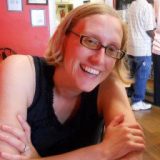I first saw Noah Lubin‘s work at the Allston Artists’ Studio a few weeks ago; my husband saw Hebrew characters in one of his paintings and suggested I talk to him about being in the column. I’m glad he did, because Noah’s art combines Jewish themes with a modernist sensibility. I asked Noah about his influences — Jewish and otherwise — and how he came to painting as his full-time career.

The truth is I love all of art history and try to learn from many painters. That being said, I feel particularly drawn to more free, intuitive art like Basquiat, late Picasso, Jean Debuffet, Karel Appel, and de Kooning. I believe that personality precedes philosophy and that the philosophies we choose are often self-serving in a large respect, at least with art, though I think this is true for much of life as well. I am someone who strives for freedom and emotional expression in all of life; I am terrible at faking or lying. The art of those mentioned is raw, intuitive, free association-based, child-like, and very individualistic. Their imaginations are larger than the eye can see. I consider them all masters in this realm. Though I have a ways to go, I feel that we are torn from the same cloth.
How does your religion manifest itself in your work?
At this point in my life, I cannot separate Torah and ritualistic life from my perception and interpretation of the world around me. At the same time, I cannot ignore that I grew up secular or went to college or read history and philosophy. And so I try to integrate the entirety of my life into an honest whole. This is a magical balancing act that we all must do quite often if we are reflective and honest.
Art for me is a mirror of life; if it sits on the side and comments, it is a failure. It must be face to face with us. And so I am continually attempting to capture, in painting, my interpretive imagination and how it filters experience for me. I am continually trying to develop the skills to do this most effectively. I wish to show what I call an urban, contemporary Judaica, which is radical in some ways within traditional Jewish art and most true to who I am. I am not interested in folklore and dancing Chassidim with violins. In fact, I’ve never seen one. My art would be untrue.
You were a school teacher before this? How did you come into this line of work?
I am still a school teacher. I will always be one, even if I’m not teaching. I am someone interested in the classroom environment as a primary or essential space for discourse and exchange. As a reflective person, this is of the highest value to me.
My mother was a school teacher. Though she thought I would be well-loved by students and would make an important educator if I found the right space, she was worried that I was too free and wouldn’t fit the bill, so to say. She felt that I would be misunderstood and that schools didn’t really want creative types like me. In their minds, they did, but they would be uncomfortable with aspects of my personality that I cannot hide. She wanted me to be an artist. Let’s just say she was right. She was an artist as well.
What’s your favorite color?
Like a parent, I love all my children. It brings me nachas to see them get along.
Explore more Arts and Culture on JewishBoston.com.

This post has been contributed by a third party. The opinions, facts and any media content are presented solely by the author, and JewishBoston assumes no responsibility for them. Want to add your voice to the conversation? Publish your own post here. MORE


